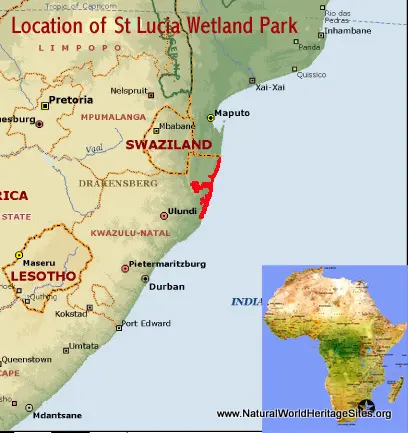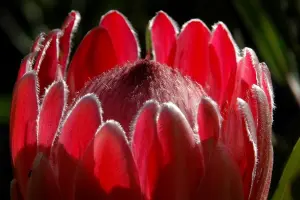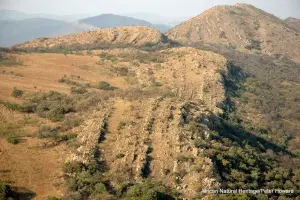EXPLORE SOUTH AFRICA’S ISIMANGALISO (ST LUCIA) WETLAND PARK with this slideshow, check the location map and get all the facts and information below.
For slideshow description see right or scroll down (mobile). Click to view slideshow
Values: The iSimangaliso (St Lucia) Wetland Park covers one of the largest estuarine systems in Africa, and the world heritage site encompasses a 220km-long strip of coastal lowlands, including the St Lucia estuary itself, the surrounding mosaic of swamps, woodlands, grasslands and dune forest, as well as a marine reserve of beaches, offshore marine environments and coral reefs. These provide critical habitat for a wide range of species from Africa’s seas, wetlands and savannas including large populations of nesting turtles and aggregations of flamingos and crocodiles. The interaction of major floods and coastal storms on these environments fuels a process of continuing ecological change. The St Lucia system supports over 350 bird species and is the most important breeding area for waterbirds in South Africa, with at least 48 breeding species recorded.
A comprehensive review of the world heritage values of the iSimangaliso Wetland Park is provided below, together with details of the area’s conservation status and the threats it faces.
REVIEW OF WORLD HERITAGE VALUES: According to IUCN’s Conservation Outlook Assessment (2014), the specific attributes which qualify iSimangaliso Wetland Park for world heritage status can be summarised as follows:
Complex interaction of fluvial, marine and aeolian ecological processes. iSimangaliso represents an outstanding example of ongoing ecological and biological processes in the evolution and development of terrestrial, fresh water, coastal and marine ecosystems, and associated communities of plants and animals. The combination of fluvial, marine and aeolian (wind) processes initiated in the early Pleistocene has resulted in a variety of landforms and continues to the present day. Past speciation events in the Maputoland Centre of Endemism are on-going and contribute to the diversity and interplay of evolutionary processes at work. In the marine component of the site, the sediments being transported by the Agulhas current are trapped by submarine canyons on the continental shelf allowing for remarkably clear waters and the development of coral reefs. The interplay of this environmental heterogeneity is further complicated by major events such as droughts, floods and coastal storms, which are regularly experienced at the site. Most importantly, the site is large enough to retain most of the key elements that are essential for long-term functioning of these complex ecosystem interactions.
Outstanding diversity of natural habitats. There are five major ecosystems represented in the park, namely the (i) marine ecosystem, characterised by a warm sea, the southernmost extension of coral reefs in Africa, submarine canyons and long sandy beaches; (ii) coastal dune system, consisting of linear dunes up to 180 m in height, sub-tropical forests, grassy plains and wetlands; (iii) lake systems, consisting of two estuarine-linked lakes (St Lucia and Kosi) and four large freshwater lakes (Sibaya, Ngobozeleni, Bhangazi North and Bhangazi South); (iv) swamp systems (uMkhuze and uMfolozi) with swamp forest, extensive reed and papyrus wetlands; and (v) inland savannas on the western shores, with ancient shoreline terraces and dry savannah woodlands, thickets and sand forests that occur on the higher lying ground between the coastal plain and the Lubombo Mountains.
Outstanding diversity of species. The site’s transitional location between sub-tropical and tropical Africa as well as its coastal setting have resulted in exceptional species diversity. iSimangaliso Wetland Park contains some of the most important and significant natural habitats for the in-situ conservation of biological diversity anywhere in Africa with over 6,500 plant and animal species known to occur. As iSimangaliso is situated on the southernmost extremity of the Mozambique coastal plain, many species characteristic of lowland habitats to the north reach the southernmost limit of their range at iSimangaliso.
Important habitat for rare, threatened and/or endemic species. The five interlinked ecosystems found in iSimangaliso Wetland Park provide habitat for a large number of rare, threatened and/or endemic species. These include 11 species that known only from this park, and 108 species endemic to South Africa. There are 48 species listed as internationally threatened, 467 listed as threatened in South Africa and 147 listed under the Convention on International Trade in Endangered Species (CITES).
Importance for nesting turtles and large aggregations of waterfowl. The large numbers of nesting turtles on the beaches, the abundance of dolphins and migration of whales and whale sharks off-shore are all outstanding natural phenomenon. The substantial numbers of waterfowl and large breeding colonies of pelicans, storks, herons and terns are impressive. iSimangaliso Wetland Park is the most important breeding site for waterbirds in South Africa with more than 20 000 individuals present at any given time on a regular basis.
Extraordinary natural phenomenon of shifting salinity within Lake St. Lucia. Dramatic changes in the salinity of LakeSt. Lucia from fresh to hyper-saline are linked to wet and dry climatic cycles, as well as periodic changes in the physical nature of the estuary mouth affecting the inflow of sea water.
Outstanding natural beauty along 220km of coast. The site is geographically diverse with many areas of exceptional natural beauty and aesthetic importance along its 220 km of coast. From the clear waters of the Indian Ocean, wide undeveloped sandy beaches, forested dunes and mosaic of wetlands, grasslands, forests, lakes and savanna, the iSimangaliso Wetland Park has exceptional aesthetic qualities.
CONSERVATION STATUS AND PROSPECTS: At the time of inscription on the world heritage list there were a number of concerns about the long-term conservation status of the site, particularly in relation to hydrology, alien species and local community involvement. Since then significant progress has been made to restore and enhance the site’s world heritage values through restoration projects and management interventions. These include the restoration of wetlands through the removal of commercial forestry plantations, and improvements in the hydrological functioning of the LakeSt Lucia system by re-opening waterways and channels. The Park has been fenced and boundaries have been proclaimed in law, including the extension of the marine areas under protection. There remain significant challenges in the socio-political context; over the persistence of invasive alien plants, and the prospect of upstream use of water which could affect the ecology of the wetlands.
MANAGEMENT EFFECTIVENESS: An appropriate legal framework and effective management system are in place. Implementation of a strategic plan for the restoration, rehabilitation and continued conservation of the site is well resourced and making good progress. Several issues affecting the integrity of the site at the time of inscription on the World Heritage List are being satisfactorily resolved, including the consolidation of 16 different parcels of land; fencing of the Park; implementation of alien plant control programmes; development of an Integrated Management Plan; removal and rehabilitation of former commercial forestry plantations on the Eastern and Western Shores. The staff are well-trained and sufficiently well-resourced to undertake the day-to-day management of the site, and research and monitoring programmes are carried out.
REVIEW OF CONSERVATION ISSUES AND THREATS: The following issues represent specific threats to the ecology, conservation and values of the iSimangaliso Wetland Park.
Hydrological Management and Water Use. Lake St Lucia, which constitutes a ‘core element’ of the site, has been severely affected by man-made changes in its hydrology, notably the diversion of water from one its main tributaries for agricultural use. Under natural conditions the Lake St Lucia system is highly dynamic and its waters fluctuate between fresh and hyper-saline states in response to rainfall and river flow. These changes are extremely important, enabling this estuarine system to support a number of different combinations of plants and animals contributing significantly to its rich biodiversity. The flow of one of the lake’s main tributaries (the uMfolozi River) was diverted in 1952 and canalised by sugar cane farmers, denying the lake a large part of its fresh water intake. This resulted in a failure of the system to effect periodic ‘flushing’ during flood events and led to blockage of the estuary mouth, preventing the entry of sea water into the estuary. The uMfolozi River was re-connected to Lake St Lucia in 2012, allowing the restoration of the Lake St Lucia system, restoring estuarine function and resulting in the system being open to the sea for the first time in ten years.
Despite this success in ecological restoration, upstream water use remains a threat. Water abstraction from rivers in up-stream catchments results in reduced volumes of fresh water reaching Lake St Lucia. At present levels of water abstraction, the impact on ecosystem function is not too severe, but continued close monitoring of inflows is required to ensure that the limits of acceptable change are not exceeded. Water abstraction from underground coastal aquifers (i.e. excessive pumping from boreholes) is lowering the water table and may be affecting the Sibaya and Kosi lake systems, and other coastal wetlands, but more research is required to determine its impact.
Hydrological Impact of Commercial Forestry. Commercial forestry is undertaken in the catchment of the Kosi, Sibaya and Mbazwane systems as well as in the Sokhulu and Nibela areas, and includes out-grower schemes implemented by commercial timber companies on communal land neighbouring the park. These plantation activities (together with other water requirements for residential use) are known to be having an impact on groundwater, so a moratorium on new forestry licenses has been imposed and a groundwater study has been commissioned.
Invasive Alien Species. Several alien invasive plant species (including Chromolena odorata, Psidium guajava, Casuarina equitisifolia, Lantana camara, Parthenium hysterophorus) occur in the site, predominantly in areas of disturbance. This threatens the indigenous plants which may be displaced and out-competed by the alien invasive species. An invasive alien plant control programme is being implemented, but infestations outside the site provide a perennial supply of seeds, so re-colonisation can easily occur after alien plants are removed. Invasive species of animal may also threaten the native fauna. The Asian invasive alien gastropod, Tarebia granifera has been recorded in aquatic habitats, but its possible impact remains unknown.
Poaching. Rhino poaching has affected the site, although this has been quite effectively controlled, allowing a doubling of the rhino population in recent years. The recent surge in rhino poaching has resulted in 75 rhinos being poached in KwaZulu Natal province, so continued vigilance against this serious threat is required.
Development of inappropriate tourism infrastructure. There have been small-scale illegal resort developments in the northern coast forest section of the park (KwaDapha and Mabibi) in the past, with some vegetation clearing. These have now been removed and the affected sites rehabilitated.
Expanding settlements in adjacent areas. Rural settlements near the park’s boundaries can result in pressure on park resources with incidents of illegal use, as well as serving as a source of seeds for re-colonisation of the park by invasive alien plants
Coastal Pollution. Waste material from passing ships washes up onto the beaches from time to time.
Dune stabilisation. Prior to the inscription of iSimangaliso Wetland Park on the World Heritage List, attempts were made to stabilise the coastal dunes and beachfront by planting Casuarina trees in several popular resort areas. It has subsequently been realised that this has altered the natural dune-building processes and trees have been removed.
Over-Fishing. Fish stocks in KosiLake (which represents 4.7% of the estuarine area of the park) are being over-exploited through use of illegal gill nets in addition to traditional fish harvesting methods.
Climate change. Predictions of climate change in south-eastern Africa indicate that it will become hotter and wetter and sea levels will rise. The possible future effects of this on wetland and coastal systems are a matter of speculation, requiring monitoring.
Links:
Google Earth
UNEP-WCMC Site Description
Official UNESCO Site Details
IUCN Conservation Outlook
Birdlife IBA
Slideshow description
The slideshow provides a comprehensive overview of South Africa’s iSimangaliso (St Lucia) Wetland Park showing the area’s extensive marine, coastal, wetland, forest and savanna landscapes and wildlife habitats. Some of the characteristic plants, animals and marine life is illustrated, while also highlighting some of the conservation management issues, traditional fishing methods, local community livelihoods and some typical visitor experiences.
Factfile
Website category: Marine & Coastal
Area: 2,345 km2
Inscribed: 1999
Criteria:
- (vii) aesthetic,
- (ix) ecological processes,
- (x) biodiversity





